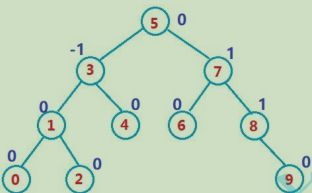c++逆天改命进阶--AVLTree
1.AVL树的概念
二叉搜索树虽可以缩短查找的效率,但如果数据有序或接近有序二叉搜索树将退化为单支树,查找元素相当于在顺序表中搜索元素,效率低下。因此,两位俄罗斯的数学家G.M.Adelson-Velskii和E.M.Landis在1962年发明了一种解决上述问题的方法:当向二叉搜索树中插入新结点后,如果能保证每个结点的左右子树高度之差的绝对值不超过1(需要对树中的结点进行调整),即可降低树的高度,从而减少平均搜索长度
一棵AVL树或者是空树,或者是具有以下性质的二叉搜索树:
- 它的左右子树都是AVL树
- 左右子树高度之差(简称平衡因子)的绝对值不超过1(-1/0/1)
上图中的 0,-1,1叫做平衡因子;
平衡因子 = 右子树的高度 - 左子树的高度
如果一棵二叉搜索树是高度平衡的,它就是AVL树。如果它有n个结点,其高度可保持在 ,搜索时间复杂度O(log(2)N);
2.AVL树的实现
AVLTree.h
#pragma once
#include test.cpp
#include "AVLTree.h"
#include 3.AVL树的性能
}
t.InOrder();
cout << t.isAVLTree() << endl;
t[3] *= 10;
t[4] *= 10;
t[5] *= 10;
t.InOrder();
AVLTree dict;
dict.Insert(make_pair("happy", ""));
dict.Insert(make_pair("hello", ""));
dict.InOrder();
dict["happy"] = "快乐的";
dict["hello"] = "你好";
dict.InOrder();
dict["happy"] += ",开心的";
dict.InOrder();
}
int main()
{
TestAVLTree();
return 0;
}
# 3.AVL树的性能
AVL树是一棵绝对平衡的二叉搜索树,其要求每个节点的左右子树高度差的绝对值都不超过1,这样可以保证查询时高效的时间复杂度,即 O(log(2)N)。但是如果要对AVL树做一些结构修改的操作,性能非常低下,比如:插入时要维护其绝对平衡,旋转的次数比较多,更差的是在删除时,有可能一直要让旋转持续到根的位置。因此:如果需要一种查询高效且有序的数据结构,而且数据的个数为静态的(即不会改变),可以考虑AVL树,但一个结构经常修改,就不太适合。
